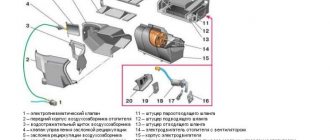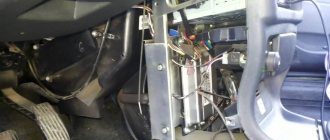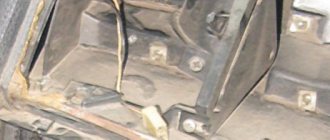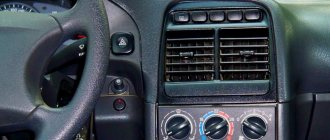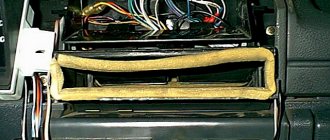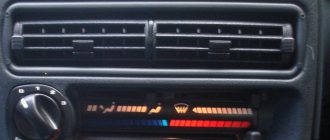The interior heater in the VAZ 2114 model has never been famous for its high reliability. During operation, this unit constantly causes the need for repairs or modifications for the owners of this model of the domestic automobile industry. Cold air coming from the windshield deflectors on the VAZ 2114 is the most common heater problem. The situation when cold air blows onto the windshield of a VAZ 2114 causes it to constantly fog up, especially in winter. Next, we will look at the causes of the problem and how to fix it yourself.
Useful video:
Stove tap failure
Quite often, the stove of a VAZ-2114 car blows cold air due to a malfunction of the faucet. In order to get rid of this problem, you should tighten the cable, which can be easily reached from the pedal assembly. You need to have pliers on hand, which, in fact, are used to tighten the cable.
If, after doing all of the above, the stove tap still does not open, there are only two reasons left:
- the faucet is sour;
- The faucet needs replacing.
By the way, this procedure should be carried out very carefully, since the tap can easily be torn off, causing the liquid to leak directly into the car interior. A faulty faucet is indicated by cold air blowing from the car's heater when it is turned on for heating.
Another reason to replace the faucet is leakage.
A faulty faucet is indicated by cold air blowing from the car's heater when it is turned on for heating. Another reason to replace the faucet is leakage.
If you decide to replace the faucet yourself, we present to your attention the sequence of actions:
- unscrew the drain plugs located on the engine block;
- drain all the coolant that is in the system;
- clean the studs on the faucet using an iron brush;
- wet them with WD-40. Thanks to this action, unscrewing will be much easier;
- loosen the clamps on the pipes and drain the remaining liquid;
- inside the car, unscrew the side trim, loosen the clamps on the pipes that are directed to the heater radiator;
- unscrew the nuts under the machine holding the tap;
- pull the tap out through the cabin;
- disconnect the cable leading to it;
- connect it to the new tap;
- check that all parts are assembled correctly;
- Proceed with the assembly process in reverse order.
Poor windshield airflow
One of the problems with the ventilation and heating systems of VAZ models is poor airflow through the windshield. Many owners, complaining about design flaws, try to make modifications or turn to service center specialists for help. However, in most cases, if the windshield blows poorly, the problem is not some kind of defect, but a simple adjustment.
As practice shows, weak windshield airflow is primarily caused by the damper. More precisely, all the problems are due to the fact that the damper control cable has become loose or has fallen off the lever. It just needs to be pulled up or put in place.
Adjusting the windshield defogger system
As we said above, in order to ensure normal airflow on the windshield of Kalina or another VAZ model, you must first check the tension of the damper control cable. To do this, you will first have to remove the left screen of the dashboard, having first unscrewed all the mounting bolts.
If you see that the cable tension is not enough to completely close the damper, you need to shorten it a little. We will need an awl and wire cutters. First you need to remove the bracket. Along its edges there are semicircular cutouts, into one of which we insert an awl and carefully remove the tip from the end of the cable. Then, using wire cutters, we bite off one turn, and then twist the remaining part. After this, we thread the end of the cable back.
To make sure that the actions are correct, we test the operation of the windshield blower. Turn on the stove and control the airflow. If the air flow is weak and cold, you can repeat the procedure and bite off another turn of the cable tip.
Note. You should not immediately bite off two or more turns of the end of the damper control cable. You can overdo it and ruin everything. It's better to do everything gradually.
After completing the cable tension adjustment, install the panel in the reverse order.
Modification of the windshield blowing system of VAZ-2113 (2114, 2115)
Almost every Samara owner complains about uneven airflow in the cabin. This is primarily expressed by the fact that hot air flows from the central air ducts (from the dashboard) to the windshield, and a cold flow comes from the side nozzles. This situation manifests itself most clearly when the heater temperature decreases when the control lever is moved to the left.
As a rule, service centers do not solve this problem. Masters claim that this is the operating principle of the system. However, you can fix everything yourself.
First, we dismantle the torpedo cover, which is installed on the left. Not far from the gas pedal there is a throttle control cable secured with a bracket. The clamp should be loosened and the cable pulled down. Then we fasten the bracket and move the right damper control lever to the left all the way, and the left one to the right all the way. In this case, a warm flow from the side air ducts will be supplied to the windshield.
However, the desired control of the temperature of the windshield blower flow will not be implemented in all modes. When the lever is moved to the left, cold air will still flow in a certain position. This is due to the fact that the lever controls both the damper and the heater valve. The damper, in turn, allows access to cold air flow.
To prevent this from happening, you should disconnect the cable that controls the damper. To do this, first remove the torpedo cover on the right and find the engine that controls the temperature. Two cables are connected to it. We select the cable located to the right and tighten it so that the damper moves to the maximum heating position. After this, we bend the cable at the attachment point. Now the damper will always be in this position. The cable should be cut off with wire cutters, leaving 15 mm. Otherwise, the extra length will interfere with the movement of the engine. After such modification, a flow of warm air will flow into all air ducts, and the temperature will be smoothly regulated in any position of the lever.
Causes, problems and solutions
The heater installed on the VAZ-2109, which has a high panel, as practice shows, does not work correctly more often than on older models. There are a few significant downsides to the center flap. Also, there are hoses for supplying heat to the feet of passengers sitting in the rear seats, which also often work incorrectly.
The stoves of cars with a low panel are free from such shortcomings, but this does not mean that they never break down.
First of all, if the heater is not working well, you should suspect a malfunction in the cooling circuit. There are several reasons:
- coolant leak;
- clogged radiator pipes;
- the formation of air locks or other malfunctions in the system.
Getting rid of bubbles is not difficult - just open the radiator cap and turn on the engine at low speed for a few minutes.
Quite often the heater tap also fails. If it leaks, it is replaced.
Cheap coolant destroys the rubber of the pipes - it cracks and a leak forms.
Sometimes the electric pump breaks down, forcing the antifreeze to move along the cooling circuit. It is also not repaired, but simply replaced.
In order for the stove to blow well, you need a working fan motor. Its breakdown is indicated by extraneous noises that occur during its operation. Sometimes it overheats - in this case
An equally important part of the system is the radiator. It can become clogged, and then the coolant, in principle, is not able to circulate normally. This part is quite easy to remove and wash.
As previously noted, poor heating is often caused by a poorly fitting damper. Because of it, part of the cold air enters the cabin from the street. Usually in this case the heat is not supplied to the feet. It’s not difficult to help trouble:
- adjust its position by tensioning the drive cable;
- seal with new foam rubber or polystyrene foam, and treat the panel seams with sealant.
Why does it blow cold on the windshield?
The supply of heated air in this location is regulated by a special damper. It is driven by a cable, which on a VAZ is generally stretched very often. This, in turn, leads to the fact that the damper itself does not open fully. In such a situation, air will be supplied inside the car directly from the street, that is, cold.
Understanding the principle by which heating functions in the VAZ-2114, it is generally not difficult to find out what the actual problem is. But even an experienced car enthusiast will need a lot of time to fix it. The thing is that the stove itself is located directly behind the panel located in the front of the cabin, near the steering wheel - troubleshooting requires its dismantling.
The problem with the cable is most noticeable when the temperature control is turned downward (that is, to the left).
Repairing heating in general is quite easy. You should proceed in this order:
- The cover under the steering wheel on the left is removed;
- the cable itself and its fastening are found near the gas pedal;
- the clamp is dismantled;
- the cable is tightened so that it does not sag;
- fixed with the same clamp;
- the damper control levers move (left to right all the way and vice versa);
- The tap regulator is set to maximum.
After this, the ignition is turned on and very soon fairly hot air begins to blow from the previously blocked holes. As practice shows, these manipulations help get rid of the problem in virtually all cases.
True, sometimes car owners note that despite the fact that the temperature regulator has begun to work much better than before, the air still flows warmer than hot. In addition, when you move it to the left, a cold stream sometimes escapes from the side deflectors, despite the heater being running. The problem here is that the specified regulator not only controls the faucet, but also the damper that prevents the supply of outside air.
To eliminate this mess, you will need to remove the cable of the damper mentioned above from the heating regulator. This is done as follows:
- remove the cover on the right side of the steering column;
- the regulator drive is found there (it has 2 cables);
- the one to the right is unhooked;
- the dismantled cable is tensioned so that the damper moves to the position of maximum heating of the interior;
- the resulting excess piece is cut off after fixing it in the old place, with a margin of no more than one and a half centimeters.
After this, the stove should work fully, and adjusting the temperature will be easy and comfortable.
VAZ 2114, practically no air blows from the side air ducts and onto the windshield, but it’s normal in the face and legs. What can be done? VAZ 2114 does not blow on the side windows.
Similar articles
11 comments on “Vaz 2114 does not blow on the side windows. There is practically no air blowing from the side air ducts or onto the windshield.”
I sympathize with the same for me.
I am also struggling with this problem.
the problem needs to be solved somehow
The cans keep their brand))
By the way, I read about a voltage converter for the generator, has anyone installed it, my wipers and lifts are working hard, they recommended it
this problem can be solved, but the process is not particularly interesting. You remove the panel and look at all the dampers on the stove to make sure they close tightly and open completely; if they don’t overlap well, which often happens, use pliers to pry the cable to kind of tighten it and voila it will blow wherever you want and it's not even bad
But ideally, you remove the entire stove, disassemble it, and when reassembling, wash all the seams with sealant and reassemble it, and with the assembled sealant you don’t have to walk much along the seam
and it will be hot in the car, you’ll kill it all day, but in cold weather you can drive in a T-shirt
I'll do it tomorrow) thanks
You remove the heater, turn off the central air duct and leave it on the side windows, glue all the dampers with foam rubber in the legs and on the windshield, insulate the outside of the heater and in the car Africa is fucked
How much will such a procedure cost in the service?)
Dismantling algorithm
VAZ cars of the classic family, which includes modification 2107, are good because to remove the heater radiator you do not need to dismantle the front panel, so the work of removing the heat exchanger of the interior heating system is not difficult. No specific tools are required, just 8 and 10 size screwdrivers and wrenches are needed.
Algorithm for removing the heater radiator:
- Drain the coolant by unscrewing the drain plugs on the engine and main radiator.
- On the left side of the engine shield (standing in front of the car) we look for two rubber tubes through which coolant is supplied and discharged to the heater. We loosen the clamps of these tubes and tighten them.
- We unscrew the screws securing the rubber seal through which the metal radiator pipes pass. Let's remove the seal.
- We move to the salon.
- We dismantle the shelf under the storage compartment on the passenger side. To do this, you need to unscrew the screws that secure it.
- Remove the lower part of the center console. It is attached to the floor and front panel with self-tapping screws. Since keys, a cigarette lighter, and a clock are installed on the lower part, after unscrewing the fastening elements, we move the box toward you (by turning on the reverse gear at the gearbox) and disconnect the wiring going to the indicated elements (it is better to mark the wires so as not to confuse them during assembly). After this, the box can be removed from the cabin.
- Unscrew the control mechanism cable from the antifreeze supply shut-off valve.
- We disconnect the lower part in which the fan is located from the stove body. It is attached to the top of the case using 4 latches installed on the sides. Use a screwdriver to pry up the latches, after which the lower part of the case will drop down. We move it to the side or completely remove it, having first disconnected the power wires of the fan motor.
- After dismantling the bottom of the case, you will have access to the radiator, which can be removed by pulling it down using the metal pipes.
Radiator installation
We recommend: Why do car headlights sweat from the inside and what to do about it?
Note that this is only one of the methods for disassembling the stove on a VAZ-2107. It is not necessary to drain the antifreeze; you can disconnect the rubber tubes without removing them, and 1.0-1.5 liters of coolant will flow out of the cooling system, which are topped up after assembly. The main thing is that after disconnecting the tubes, lift their ends up and secure them in this position.
During the disassembly process, you can immediately disconnect the pipelines from the radiator along with the shut-off valve and then remove the heat exchanger itself.
Device
If the stove suddenly starts blowing cold air or a leak develops, you must immediately begin work to detect and correct the breakdown. But in order to understand the essence of prevention and repair, you first need to understand the structure of this unit.
The interior heater includes the following elements:
- Radiator;
- Special pipes through which liquid circulates;
- Fluid circulation level adjustment valve;
- Dampers to control air flows;
- Air ducts;
- Electric fan.
If each of the units works properly, then the hot air flows will move freely through the system, exit into the cabin and blow in the direction specified by the driver.
Blowing cold air - inspection of the heater radiator and cooling system
The radiator of the VAZ-2110 stove also does not have high heat transfer, and besides, it is quite difficult to get to it. However, it may be associated with a weak interior heating temperature:
- The heater radiator is clogged. If antifreeze does not get into it when the cooling system is in full working order, then it will not heat. Diagnosing a clogged stove is difficult, but it is possible. With the engine fully warmed up and the heater on, we feel the temperature of the radiator inlet and outlet pipes by touch. If the inlet is hot and the outlet is cold, the heater radiator is clogged. Few people clean it; the public prefers to buy a new one. The market will allow you to choose several models of aluminum radiators and one or two copper ones at our discretion.
The problem of radiator obstruction is solved either by flushing using special liquids, or by replacing the element.
- Cabin filter. If the cabin filter is clogged, there is no need to talk about air supply to the cabin. We take out the filter, check its condition and change it if necessary. In winter you can do without it. Diagnostics is simple - if the temperature in the cabin returns to normal when the filter is removed, that is the problem.
It wouldn't hurt to check the cabin filter as well.
- Thermostat. Often there is a problem with the thermostat. Its valve refuses to allow antifreeze to flow into the heater circuit, so the radiator is left without liquid. The only cure is to replace the thermostat.
Checking the thermostat.
- Heater radiator leaking. A clear symptom of a malfunction is antifreeze in the cabin and a drop in the level in the expansion tank. Only replacing the heater radiator will help.
If the radiator leaks, you will have to dismantle it and replace it with a new one.
- Airlock. One of the most common problems with the cooling system and heater is an air lock. As a result, the circulation of antifreeze is disrupted and the stove does not warm up completely or does not heat up at all. The air plug is removed by releasing some of the liquid along with air from the very top of the engine - from the throttle block fitting while the engine is running. After removing the plug, the stove should restore functionality.
The problems associated with stove control are described above. But the stove may not work or not function efficiently enough for other reasons:
- the appearance of an air lock in the heater radiator;
- radiator clogged;
- severe wear or breakdown of the fan motor;
- malfunction of the rheostat block of the control mechanism;
- damper deformation.
These malfunctions affect the performance of the stove. On the VAZ-2110 they occur less frequently than control system breakdowns, but they should also be taken into account. To identify the reason for the cessation of normal operation of the VAZ-2110 stove, determine why this could have happened. If the fan does not work, then to fix the problem, check it, the rheostat unit and the power circuit.
The stove blows cold air - the reason lies in the stove radiator (clogged, a plug has formed in it) or in the dampers (jammed in a position where the air flow bypasses the radiator).
The stove heats poorly and it is not possible to adjust the temperature - check the functionality of the controller, micro-reducer and temperature sensor.
To identify the cause and eliminate the decrease in stove productivity, move “from simple to complex.” First, check the functionality of the system elements located in the cabin (controller, temperature sensor), and then climb under the hood to diagnose the operation of the gearbox, dampers, and fan motor.
Heater maintenance
To ensure that the VAZ-2114 heater heats well in winter, carry out maintenance of the heater before the cold weather:
- Remove it from the car.
- Disassemble and clean.
- Check the functionality of the dampers, seal their ends with sealants.
- Seal the joints with sealant.
- Flush the radiator.
- After assembly, adjust the drive cables so that when moving the sliders, the valves and the tap become in their extreme positions.
These measures are enough for the heating system to function normally in winter, providing warmth to the car interior.
Finally, we note that the reasons for the poor operation of the stove were discussed above, but it still continues to function. But this unit also has breakdowns and then the stove fails and stops working completely. Such reasons include breakdown of the radiator, leaks at the joints of the pipes, fan malfunction (open circuit, exhausted motor life or burnout).
First of all, you need to check the heater valve. It opens and closes with a special cable. If its tension has weakened for some reason, then when you turn the lever, the faucet either does not open at all or moves literally a few millimeters. It will need to be tightened.
It is easy to check the performance of the radiator itself by warming up the power unit while the fan is not working. All you need to do is gently touch the antifreeze supply and discharge pipes with your hand.
Getting to them is easy - you just need to open the hood.
Often, over the summer, the heater valve manages to sour, as they say. Therefore, when an attempt is made to open it, the damper simply breaks off and the drive roller remains in place. Such an element will have to be completely replaced with a working one.
If the cooling fluid level is very low, this will cause the radiator to remain relatively cold. Here you will need to look for a leak and replenish the coolant volume.
If the thermostat breaks down, it needs to be replaced with a new one, and the air lock is removed by pumping antifreeze through the system.
A failure of any main element of the heating system should be suspected only when warm air stops flowing into the cabin altogether. If its supply is limited only in several directions, then most likely we are talking about local breakdowns.
Troubleshooting methods
Methods for eliminating the problem of why the stove blows cold air at idle will depend on the reasons themselves, which have been rechecked in order. So, first of all, you need to check the coolant level in the expansion tank
Please note that this must be done on a cold engine (!!!), so that the coolant is also relatively cold and the car owner does not get burned
If it is below the middle, then add coolant. In this case, it is necessary to take into account the compatibility of antifreeze. It is advisable to fill it with the same brand and class that is in the cooling system. If the antifreeze has not been changed for a long time and/or is in poor condition, then it is better to replace it with a new one.
If air pockets form in the cooling system, they must be removed. There are three main methods for removing air from the cooling line. They all boil down to allowing the engine to run with the system depressurized so that the air can come out of the system on its own during the antifreeze circulation process. You can perform the procedure for removing air from the cooling system yourself in the garage or even in the field.
When the check shows that the pump is faulty, it will have to be replaced accordingly. But to identify the problem, you will have to dismantle the water pump. Often the cause of failure lies in wear of the impeller, bearing, or depressurization of seals. As for the bearing and rubber seals, in some cases they are replaced with new elements.
If the reason lies in the difficulty of the passage of liquid through the heater radiator, then you can try to rinse it. At the same time, it will be possible to see if it has cracked the body, and, accordingly, if antifreeze is flowing through it and if air is being sucked in. Typically, flushing has a positive effect on the efficiency of the heater, including at idle speed of the engine, as well as when the car is driving on the highway or in the city driving cycle at high speeds.
If the car heater has a valve for supplying liquid to the radiator, then do not forget to check its operation. So, for example, on VAZs (both new and old), this is one of the weak points of the interior heating system.
When the stove heats poorly only when starting on a cold engine and the engine itself does not reach operating temperature for a long time, then the first thing you should do is check the operation of the thermostat. So, for the first few minutes, until the coolant reaches an operating temperature of about +80°C...+90°C, the pipe leading to the top of the main radiator will be cold and relatively soft. The thermostat valve should only open when the antifreeze is warm enough. If yours is different, the thermostat must be replaced. In rare cases, you can try to repair it, but it is better to install a new one.
The car's climate control system operates on the basis of its own separate software and hardware. Therefore, checking its operation depends on the specific brand of car and the type of system itself. The verification algorithm is usually described in the car manual. If such information is available, you can check it yourself. Otherwise, it is better to seek help from a car service center, preferably one that specializes in working with the specific brand of car being tested.
Conclusion
If the stove heats only when moving, first of all you need to check the level of antifreeze in the cooling system, as well as its condition. Next, you need to check the pump, thermostat, radiator, heater valve, and the presence of air pockets in the system.
If, when the engine warms up at idle, the heater blows cold for too long, then it makes sense to insulate the radiator grille with improvised or special means. In any case, remember that a poorly functioning stove in any case indicates problems in the engine cooling system, and operating a car with similar problems is fraught with costly repairs in the future, so repair work must be carried out as quickly as possible.
FAQ:
- Kalina's stove doesn't heat well at idle
- Skoda Octavia heater does not blow at idle
- Audi A6 heater blows cold at idle
Fan motor repair
If the electric motor malfunctions, it should first be removed and then the feasibility of repair should be determined. It is necessary to evaluate the condition of the brushes, armatures, windings, and check the integrity of the wire insulation. The contact area of the brushes on the armature can be cleaned with zero grade sandpaper. You should also pay attention to the bushings and bearings - clean the rubbing parts from dirt and apply lubricant (for example, Litol). All elements with signs of wear must be replaced.
How does the stove work in a car?
Before you begin to identify the reason why, when the car is stopped, the stove refuses to heat, we recommend that you understand how heating works. After all, knowing the basics of its functioning, you can easily find a breakdown.
Both the small sedan and the truck are made of metal. Therefore, the body is strongly affected by temperature changes:
- In hot weather, the car warms up to a temperature of 40–50 degrees Celsius. In winter, it will be only a couple of degrees warmer in the car than outside. To move your car comfortably during the summer months, we use an air conditioning system.
- During the cold season, you can maintain optimal temperatures in your car using a heating system. Moreover, in our country you have to use the stove most of the year, so it must provide heat.
Previously, the car was warmed up using a stove-stove, as well as gas lamps. And only in 1917, they began to install an autonomous heating system on cars produced in America: the car began to heat up due to the heat from the exhaust pipe. For example, this heating method was used in the 1929 Ford Model A. In addition, cars began to warm up with an installed radiator, which was blown by a fan. This heating system was used on General Motors models. Over the years, every car began to be heated using such a system.
Each modern car is equipped with a heating unit, which is made of such components as:
- fan motor;
- air duct system;
- inlet and outlet pipes;
- stove heat exchanger;
- faucet that regulates the supply of coolant;
- heating equipment control unit;
- dampers, the drive of which can be mechanical or electric.
Usually the car is equipped with a stove, which is located behind the front panel. 2 tubes extend from it, supplying coolant to the radiator. It moves thanks to a pump (pump) both through the engine cooling system and through the heating system.
Heat exchange is possible due to the heating of the motor. Its cooling occurs due to antifreeze: it takes away thermal energy. The heated antifreeze enters the radiator of the stove, which heats according to the same principle as a standard battery in your home. At the same time, the stove fan starts working. It ensures the movement of cold air through the radiator. Here again there is an exchange of heat: the air is heated by the radiator, cooling it at the same time.
The heated air flow is directed into the cabin, and the cooled antifreeze enters the engine, where the heating process begins again. This heating system is used in most cars because its efficiency is quite high. In winter, the car will warm up provided that air with a temperature of 30 degrees Celsius is blown from the stove. This not only ensures that the interior is warmed up, but the windows also remain fog-free. A blower mode switch is installed on the dashboard. With its help, you can change the location of the dampers that regulate the air flow. It can be directed straight, down, up.
Almost all the time, warm air should be directed upward - that is, onto the windshield. This is the only way to maintain an optimal level of pressure in the cabin, when condensation does not form on the glass, and dust microparticles do not penetrate inside the car.
The stove plays the role of another radiator. Therefore, when the car is cold and you turn on the heat, the entire system begins to cool down. As a result, the walls of the radiator rust, the engine, like the car, takes longer to warm up. Air humidity rises, windows fog up from the inside. This means that the stove can only be turned on if the coolant temperature has risen to at least 50 degrees Celsius.
Cleaning and flushing the radiator of the VAZ 2114/15 stove
You can increase the efficiency of the stove by cleaning and flushing the radiator. The procedure can be performed without dismantling the radiator or with dismantling it. In the first case, you will need to remove the outlet and inlet pipes from the heater and pour a cleaning solution into it. Citric acid, plumbing cleaners (for example, “Mole”), etc. are used as such a solution. Then the radiator is washed with running water and coolant is added. You can clean the radiator better by removing it from the car. This will allow you to wash it not only from the inside, but also from the outside, removing dirt between the honeycombs. Washing is usually carried out with running water.
If after performing these procedures the stove does not work better, the radiator must be replaced.
The stove doesn't heat well
A poorly heating or non-heating stove on a VAZ 2114 and on other cars of the SAMARA and SAMARA-2 model range is a big problem in the winter. I hope that this article will help you solve your problem, and in 30 degree frost you will sit in comfort and warmth.
Why does the stove heat poorly or not heat?
Below are the main reasons for a poorly functioning or non-functional stove, as well as ways to solve the problem.
1. The stove fan does not turn on.
2. The thermostat is not working.
If the thermostat is not working, then it constantly circulates coolant in a large circle, which does not have time to heat up, and as a result, the stove does not heat.
An air lock is formed as follows: after the engine is running, when the coolant cools, air penetrates into the upper part of the radiator, from where it moves to the thermostat. In the morning we start the engine, and the pump circulates air into the interior heater radiator. To remove an air lock, use the corresponding article: How to remove an air lock?. There is also another way: we drop the pipe onto the stove, and slowly add antifreeze there until it is full.
4. The stove faucet does not open completely.
In 90% of problems with a poorly heating stove, the problem lies precisely in this. In this case, you do not need to tighten the cable of the stove faucet. You need to bend the cable from the gas pedal; when you bend over, you will see it. You just need to use pliers to pull the cable to increase its tension. If the stove faucet does not open, then most likely it has soured and needs to be replaced: How to replace the stove (heater) faucet? If you still try to open it, there is a chance that you will rip it off and flood everything with coolant.
5. The heater radiator is clogged.
In this case, you need to remove the heater radiator and thoroughly blow it out or install a new one: How to replace the heater radiator? .
6. Fan impeller.
If the heater radiator is hot, then the problem is most likely in the fan impeller. There is a multidirectional impeller.
7. Poor quality heater radiator.
The fact is that there is a heater radiator made in Ukraine. This radiator simply does not provide for high heat transfer to the interior by design. Therefore, it is better to use a DAAZ radiator.
8. The pump does not create the required pressure.
If, for example, the stove does not heat up at idle, and the stove only heats up at speed, then the problem is with the pump. The bottom line is that the pump does not ensure normal circulation of coolant and then the fluid is weak. Similar symptoms are also accompanied by low coolant levels. Instead they put in a duralumin pump, Belmag. There have been a lot of fakes of HEPU lately, so I don’t advise you to use this manufacturer.
9. Low coolant level.
The coolant level should be at the max mark or a finger higher (in winter).
10. There is an option to add an electric pump from Gazelle.
11. The cylinder head gasket has burned out.
If oh. the liquid smells like gasoline or exhaust; The engine oil smells wow. Liquid; Thick white smoke is coming from the muffler, then the cylinder head gasket has most likely broken.
12. The cabin heater filter is clogged.
Also see other useful articles on this topic: The VAZ stove does not work, what should I do?
Solving the problem
First of all, you need to check the heater valve.
It opens and closes with a special cable. If its tension has weakened for some reason, then when you turn the lever, the faucet either does not open at all or moves literally a few millimeters. It will need to be tightened. It is easy to check the performance of the radiator itself by warming up the power unit while the fan is not working. All you need to do is gently touch the antifreeze supply and discharge pipes with your hand.
Getting to them is easy - you just need to open the hood.
Often, over the summer, the heater valve manages to sour, as they say. Therefore, when an attempt is made to open it, the damper simply breaks off and the drive roller remains in place. Such an element will have to be completely replaced with a working one.
If the cooling fluid level is very low, this will cause the radiator to remain relatively cold. Here you will need to look for a leak and replenish the coolant volume.
If the thermostat breaks down, it needs to be replaced with a new one, and the air lock is removed by pumping antifreeze through the system.
A failure of any main element of the heating system should be suspected only when warm air stops flowing into the cabin altogether. If its supply is limited only in several directions, then most likely we are talking about local breakdowns.
Coolant level
As for the low level of antifreeze, here things are much simpler. If the antifreeze level is not at the maximum level (and this should not be the case in winter), add coolant slightly above the MAX mark.
Sometimes the coolant may smell like gasoline. If so, you most likely have a blown head gasket. In this case, it needs to be replaced. It is inexpensive, and the replacement itself will not take more than 10 minutes of your time. The gasket itself serves in different ways - from 10 to 40 thousand kilometers, depending on the manufacturer and the operation of the car.
If the stove does not work, the VAZ-2114 needs to be checked for clogging of the cabin filter. It comes off very easily. The service life of this element is about 10-15 thousand kilometers. If you have not changed it during this period, most likely the reason lies in a clogged filter.
Diagnostics
The most important thing in repair is a competent diagnosis, identifying the primary cause of the malfunction. We'll start with the engine compartment. Check the coolant level. We start the engine and warm it up to operating temperature. If the engine gains temperature and the pipe before the thermostat is warm and after it is cold, this means that the thermostat is working and the problem is not in the engine cooling system, but in the cabin heater.
Reason #1
The heater damper control cable has become loose or has come off.
Solution
- Disassemble the driver's side panel.
- There is a damper control lever on top. A cable from the control lever on the center console (cold - hot) comes to it.
- We visually inspect the cable itself and the damper control lever.
- If everything is intact, then it just stretched.
- Unscrew the cable bracket and remove it from the lever.
- We take the eye of the cable with pliers and turn it clockwise so that the cable becomes shorter.
- We assemble everything in reverse order.
- Without assembling the side panel, let's check it.
In most cases, the cause of the malfunction is the cable, but if the problem is not solved and the stove continues to blow cold air into your feet, then we’ll look into it further.
Reason #2
The air ducts and dampers are poorly assembled and there are gaps between the joints. The air ducts themselves can be severely broken at bends and not allow air to pass through, then warm air simply blows only from the central deflectors and heats the panel itself inside.
Solution
- We inspect the air ducts. If there are cracks or kinks, it is better to replace the air duct with a new one.
- We seal the flaps with self-adhesive foam rubber.
Such simple tips will help owners make their trips comfortable in cold weather, and especially in winter, when a foggy windshield can make further movement impossible, or can lead to an accident. Well, if these tips didn’t help you, then it’s much more serious and you most likely won’t be able to solve this problem yourself. And in this case, you need to contact a service station. But in most cases, the problem can be solved using the above methods.
The heating system of any car is designed to create and maintain a comfortable microclimate in the cabin. The VAZ 2114/15 stove is considered quite reliable. However, it requires periodic maintenance and repair. You can do all this yourself.
Pinout of mounting block 2109
The VAZ 2109 mounting block is designed to combine wiring harnesses, as well as to accommodate relays and fuses. The first models used a mounting block type 17.3722. It consists of a housing consisting of two parts and a printed circuit board on which leads are soldered for connection to the wiring harness blocks, installation of relays and fuses.
On cars with an injection engine, mounting blocks similar to 2114-3722010-60 are used, but they have a different connection for the radiator cooling fan.
| Fuse no.' | Protected Circuits |
| 1 (8 A) F9 (7.5 A) | Right fog lamp |
| 2 (8 A) F8 (7.5 A) | Left fog lamp |
| 3 (8 A) F1 (10 A) | Headlight cleaners (at the moment of switching on). Relay for turning on headlight cleaners (contacts). Headlight washer activation valve |
| 4 (16 A) F7 (30 A) | Headlight cleaners (in operating mode). Relay for turning on headlight cleaners (winding). Heater fan motor. Window washer motor. Rear window wiper motor. Rear window washer timing relay. Valves for turning on the windshield and rear windows. Relay (winding) for turning on the electric fan of the engine cooling system. Relay (coil) for turning on the heated rear window. Control 'Lamp for heated rear window. Glove compartment lamp |
| 5 (8 A) F16 (15 A) | Direction indicators and relay-interrupter for direction indicators and hazard warning lights (in turn indication mode). Turn signal indicator lamp. Rear lights (reversing lamps). Gearmotor and windshield wiper activation relay. Generator excitation winding (when starting the engine). Brake fluid level warning lamp. Oil pressure warning lamp. Carburetor air damper warning lamp. Parking brake warning lamp. Light display lamp "STOR". Coolant temperature gauge. Fuel level indicator with reserve warning lamp. Voltmeter |
| 6 (8 A) FZ (10 A) | Rear lights (brake lamps). Interior lighting |
| 6(8 A) F6 (30 A) | Power windows for front doors. Power window relay |
| 7 (8 A) F10 (7.5 A) | License plate lights. Engine compartment lamp. Instrument lighting lamps. Indicator lamp for external lighting. Heater lever illumination display. Cigarette lighter lamp |
| 8 (16 A) F5 (20 A) | The electric motor of the engine cooling system fan and its activation relay (contacts). Sound signal and relay for its activation |
| 9 (8 A) F10 (7.5 A) | Left headlight (side light). Left rear light (side light) |
| 10 (8 A) F11 (7.5 A) | Right headlight (side light). Right rear light (side light) |
| 11 (8 A) F2 (10 A) | Direction indicators and hazard warning relay-breaker (in hazard warning mode). Hazard warning lamp |
| 12 (16 A) F4 (20 A) | Rear window heating element. Relay (contacts) for turning on the heated rear window. Plug socket for portable lamp. Cigarette lighter" |
| 13 (8 A) F15 (7.5 A) | Right headlight (high beam) |
| 14 (8 A) F14 (7.5 A) | Left headlight (high beam). Indicator lamp for high beam headlights |
| 15 (8 A) F13 (7.5 A) | Left headlight (low beam) |
| 16 (8 A) F12 (7.5 A) | Right headlight (low beam) |
Heater fuse and reasons for its failure
Often the cause of malfunction of most components and systems of a car is a blown fuse. The stove is no exception. Failure of a 30A heating system fuse causes the fan motor to stop and air to stop flowing into the cabin. In this case, find an element marked F7 in the fuse block and replace it. The new fuse should also be rated 30A. If the fan does not work after this, the problem should be looked for elsewhere.
It is often difficult to determine that it is the fuse that has blown. It can fail due to a short circuit in the electrical wiring, a malfunction of the electric motor, severe clogging of the cabin filter and in a number of other situations. The difficulty lies in the fact that fuse F7 is simultaneously included in the rear window heating electrical circuit and is responsible for the cigarette lighter, glove compartment lighting and headlight washer motor. If it fails, all these components will not work.
